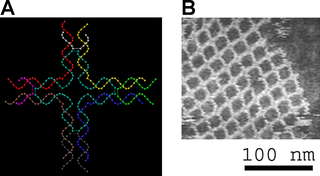In physics, the term dielectric strength has the following meanings:
In electrical engineering, partial discharge (PD) is a localized dielectric breakdown (DB) of a small portion of a solid or fluid electrical insulation (EI) system under high voltage (HV) stress. While a corona discharge (CD) is usually revealed by a relatively steady glow or brush discharge (BD) in air, partial discharges within solid insulation system are not visible.

A Lichtenberg figure, or Lichtenberg dust figure, is a branching electric discharge that sometimes appears on the surface or in the interior of insulating materials. Lichtenberg figures are often associated with the progressive deterioration of high voltage components and equipment. The study of planar Lichtenberg figures along insulating surfaces and 3D electrical trees within insulating materials often provides engineers with valuable insights for improving the long-term reliability of high-voltage equipment. Lichtenberg figures are now known to occur on or within solids, liquids, and gases during electrical breakdown.

A nanostructure is a structure of intermediate size between microscopic and molecular structures. Nanostructural detail is microstructure at nanoscale.
Transformer oil or insulating oil is an oil that is stable at high temperatures and has excellent electrical insulating properties. It is used in oil-filled wet transformers, some types of high-voltage capacitors, fluorescent lamp ballasts, and some types of high-voltage switches and circuit breakers. Its functions are to insulate, suppress corona discharge and arcing, and to serve as a coolant.

In electrical engineering, treeing is an electrical pre-breakdown phenomenon in solid insulation. It is a damaging process due to partial discharges and progresses through the stressed dielectric insulation, in a path resembling the branches of a tree. Treeing of solid high-voltage cable insulation is a common breakdown mechanism and source of electrical faults in underground power cables.
A ferroelectret, also known as a piezoelectret, is a thin film of polymer foams, exhibiting piezoelectric and pyroelectric properties after electric charging. Ferroelectret foams usually consist of a cellular polymer structure filled with air. Polymer-air composites are elastically soft due to their high air content as well as due to the size and shape of the polymer walls. Their elastically soft composite structure is one essential key for the working principle of ferroelectrets, besides the permanent trapping of electric charges inside the polymer voids. The elastic properties allow large deformations of the electrically charged voids. However, the composite structure can also possibly limit the stability and consequently the range of applications.
IEEE Transactions on Computer-Aided Design of Integrated Circuits and Systems is a monthly peer-reviewed scientific journal covering the design, analysis, and use of computer-aided design of integrated circuits and systems. It is published by the IEEE Circuits and Systems Society and the IEEE Council on Electronic Design Automation. The journal was established in 1982 and the editor-in-chief is Rajesh K. Gupta. According to the Journal Citation Reports, the journal has a 2022 impact factor of 2.9.
VLF cable testing is a technique for testing of medium and high voltage cables. VLF systems are advantageous in that they can be manufactured to be small and lightweight; making them useful – especially for field testing where transport and space can be issues. Because the inherent capacitance of a power cable needs to be charged when energised, system frequency voltage sources are much larger, heavier and more expensive than their lower-frequency alternatives. Traditionally DC hipot testing was used for field testing of cables, but DC testing has been shown to be ineffective for withstand testing of modern cables with polymer based insulation. DC testing has also been shown to reduce the remaining life of cables with aged polymer insulation.
Condition monitoring of transformers in electrical engineering is the process of acquiring and processing data related to various parameters of transformers to determine their state of quality and predict their failure. This is done by observing the deviation of the transformer parameters from their expected values. Transformers are the most critical assets of electrical transmission and distribution systems, and their failures could cause power outages, personal and environmental hazards, and expensive rerouting or purchase of power from other suppliers. Identifying a transformer which is near failure can allow it to be replaced under controlled conditions at a non-critical time and avoid a system failure.
The IEEE Transactions on Signal Processing is a biweekly peer-reviewed scientific journal published by the Institute of Electrical and Electronics Engineers covering research on signal processing. It was established in 1953 as the IRE Transactions on Audio, renamed to IEEE Transactions on Audio and Electroacoustics in 1966 and to IEEE Transactions on Acoustics, Speech, and Signal Processing in 1974, before obtaining its current name in 1992. The journal is abstracted and indexed in MEDLINE/PubMed and the Science Citation Index Expanded. According to the Journal Citation Reports, the journal has a 2022 impact factor of 5.4. The editor-in-chief is Wing-Kin (Ken) Ma.
A severity factor is established as a coefficient to assess the dielectric severity supported by a transformer winding considering the incoming transient overvoltage. It determines the safety margin regarding to the standard acceptance tests either in the frequency or time domain.
Reimund Gerhard is a German applied physicist and university professor. Between 1979 and 2006 he used the last name "Gerhard-Multhaupt".

Antonio Castellanos Mata was a Spanish physicist.

IEEE Transactions on Medical Imaging is a monthly peer-reviewed scientific journal published by the Institute of Electrical and Electronics Engineers (IEEE). It covers technological aspects of medical imaging techniques. The journal was established in 1982 and since 2019 the editor-in-chief is Leslie Ying. It is sponsored by four IEEE societies, IEEE Engineering in Medicine and Biology Society, IEEE Signal Processing Society, IEEE Nuclear and Plasma Sciences Society, and IEEE Ultrasonics, Ferroelectrics & Frequency Control Society.

Hans Tropper (1905–1978) was an Austrian Professor of Electrical Engineering with research interest in breakdown strength of liquid insulation. The ‘Hans Tropper Memorial Lecture’ is held in his honour to open each IEEE International Conference on Dielectric Liquids. He also briefly worked for Elin Aktiengesellschaft fur Elektrische Industrie.

IEEE Transactions on Robotics is a bimonthly peer-reviewed scientific journal published by the Institute of Electrical and Electronics Engineers (IEEE). It covers all aspects of robotics and is sponsored by the IEEE Robotics and Automation Society. The editor-in-chief is Kevin Lynch.
Hulya Kirkici is a Turkish-American electrical engineer whose research interests span a wide range of topics including insulators for aerospace applications, pulsed power, the use of advanced materials in plasma switches and vacuum electronics, pulsed plasma, and beam shaping for lasers and lidar. She is professor and chair of the Electrical and Computer Engineering Department at the University of South Alabama.

Cumyl alcohol, also called 4-isopropylbenzyl alcohol, is a liquid, hydroxy functional, aromatic organic chemical with formula C10H14O. It has the CAS Registry Number of 536-60-7 and the IUPAC name of (4-propan-2-ylphenyl)methanol. It is REACH registered with the EC number of 208-640-4.







